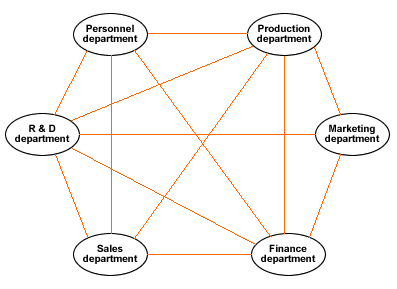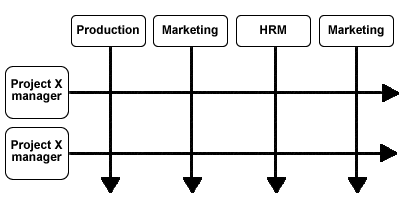Matrix structure / Project teams


Matrix structure
A matrix structure is a form of organisation based on horizontal and vertical relationships.
The matrix structure is linked closely to project management.
Project management became popular in the early 1960s, driven by businesses which realised that there were benefits from organising work into separate definable units and from coordinating different kind of skills across department and professions. One of the first major uses of project management was the organisation of the US space programme.
New plants, new methods, new ventures all require dedicated project teams working to strict timetables with a dedicated budget. Managers may spend as much time in cross-functional project teams as they do in their normal posts.
A matrix structure allows for flexibility in operations. By adopting this form of organisational structure the business can draw together experts from several fields to work as a team. The diagram below shows a possible matrix structure.

Figure 1 Matrix structure
Matrix structures normally involve the creation of project teams. Each project team has specific responsibilities and team managers meet often with each other to look at areas relevant to each other. This type of organisation should widen the range of opinions being considered within the team and the project manager can call on expertise from several business functions, such as marketing and finance. An appointed project manager is responsible for the work of the team. Tasks are delegated to functional experts. At the end of the project, the team often disbands. Teams may employ full time staff who move onto other teams or external members who may move onto jobs with other firms.

Figure 2: Project teams
The choice facing many businesses is whether to keep to the older functional style, which has clearly defined hierarchies, that allows clear definitions of responsibility and accountability, or to move to the matrix style, which encourages flexibility. Matrix structures may be more appropriate where firms are considered to be of a 'Theory Y' nature (see section on motivation theory).
The advantages and disadvantages of a matrix structure therefore include:
Advantages
- Flexibility
- Brings together teams from different disciplines with different skills
- Encourages creative thinking
- Offers a decentralised form of organisation
- Allows managers to focus on strategic planning
- Encourages cooperation between different functional areas and divisions
- Can be used within more tradition bureaucratic or pyramid structures to encourage creative and flexible approaches
Disadvantages
- The structure may lead to power struggles between different departments
- Team members may have two managers - the project team manager and their functional line manager. This may lead to conflicts.
- May be costly to implement and require a change in corporate culture
- May be seen as a 'talking shop' and encourage discussion rather than action
- Can lead to slower decision-making because of the requirement for agreement and cooperation
- Can create problems of control and authority with overlapping lines of authority
